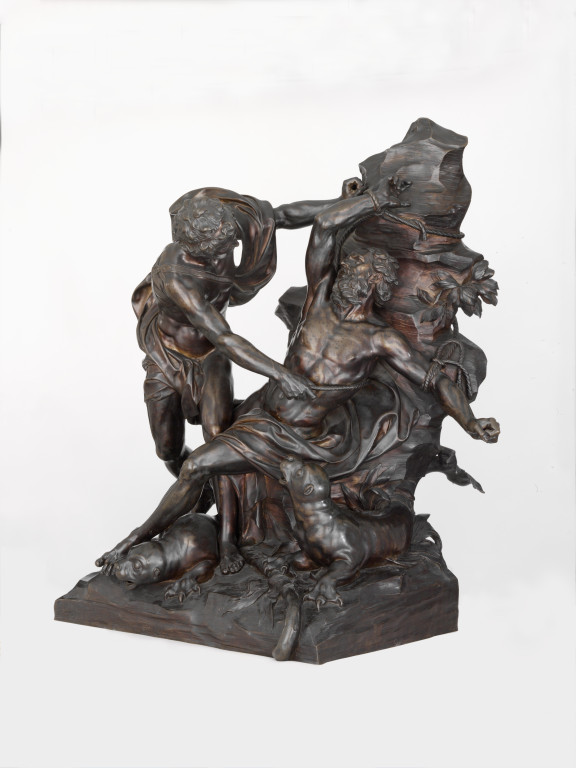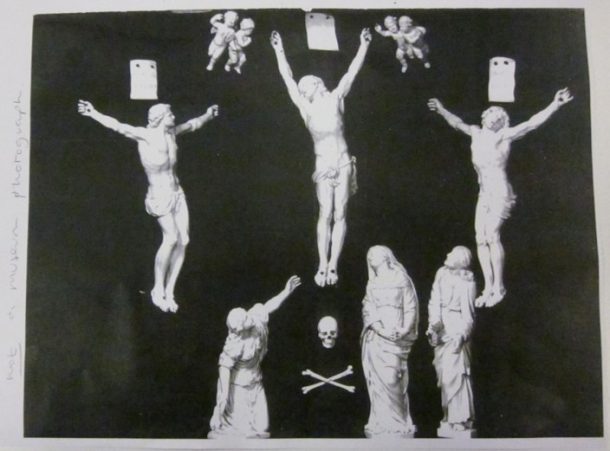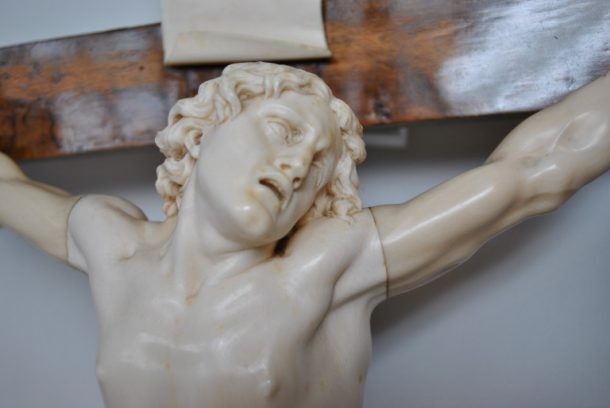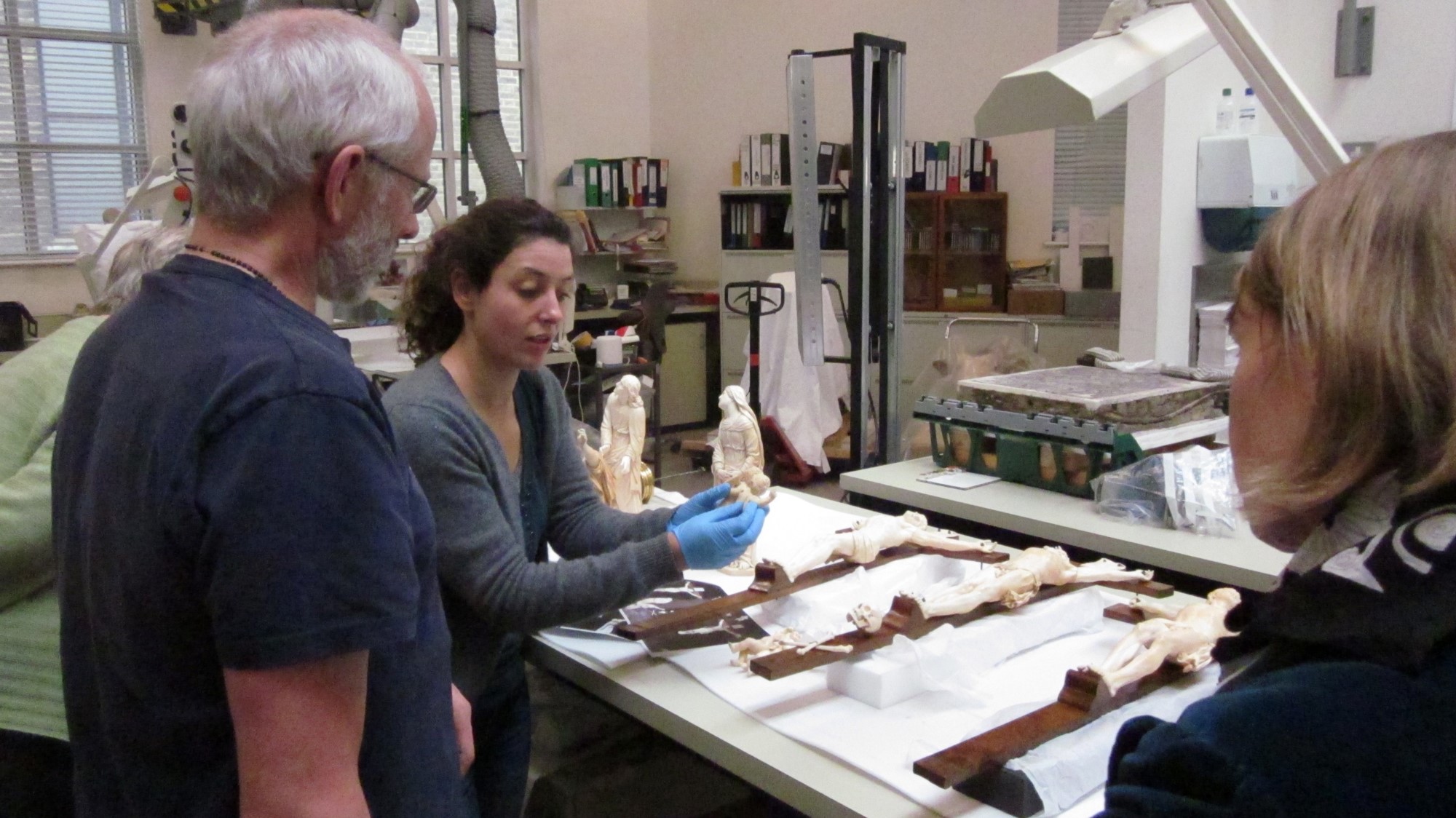On the festivities front it may be the wrong time of year for it, but we have recently been discussing how to display The Crucifixion.
This wonderfully detailed ivory group will feature in one of our displays looking at Catholicism and, whilst others are deciding how to display their nativity scenes, we have been deciding how exactly to arrange the figures of this 17th century Crucifixion.

The grouping is one of the few documented examples of French ivory carving in the 17th century and was probably intended as an altarpiece for a private chapel, this group.
The group of figures consists of the Crucified Christ, with an ivory scroll inscribed in Hebrew, Latin and Greek, and ivory skull and crossbones; the Good Thief and the Bad Thief, each with a scroll inscribed; the sorrowing Virgin; St. John the Evangelist; the kneeling figure of Mary Magdalene, and two pairs of angels to be suspended above the group.

The ivories are the work of the French sculptor Pierre Simon Jaillot (1631-1681), and are signed and dated ‘P S Jaillot 1664’. However, the earliest record of the group is from when they were presented to the Cure of St Germain l’Auxerrois, Paris, in 1787. The Museum acquired the group almost 200 years later in 1984, with support from the ArtFund.
Jaillot was a member of the Académie de Saint-Luc and was received into the Académie royale de peinture et de sculpture in 1661, presenting an ivory carving: A Christ dying on the cross. He appears to have worked primarily in ivory but the large scale of the figures in this group suggests the close connections of his work with French monumental sculpture by artists such as Girardon.

Jaillot was particularly admired for his crucifix figures. Another crucifix by him was recorded at Ailles in the late 19th century, but is now lost. Our group going in to the galleries is the only signed and dated piece known by him, and is regarded as his most ambitious work.
Despite his great skill, Jaillot perhaps became most renowned for his ill-advised and acrimonious dispute with Louis XIV’s artistic advisor, Charles Lebrun. This dispute resulted in his expulsion from the Académie in 1673.
Thankfully, there were no such incendiary disputes when it came to conservators, curators and technicians considering how the group should be shown in the new Europe Galleries.

With all of the pieces out in the Sculpture Conservation Studio, this was a great opportunity to be able to move the figures around and see how positioning them at different angles and distances can change the effect of their gestures and expressions. We need to ensure that the dramatic gazes of the figures at the base of the crucifixes are not only directed at the right thing, but that they also allow their incredible carving to be shown off to best effect and work together as a unified group.

To help guide discussion we referred to images of earlier configurations of the group.



All were agreed that the basic arrangement of the figures should repeat that shown above in black & white, however the space available in the display case that will house it provides some spacial freedom in their exact positioning. To keep a sense of them being a group, it was felt necessary for them to be displayed using a simple block.
This session was also a useful moment to discuss the practicalities of mounting/supporting the various pieces for display. As the conservators are busy working on them, they were able to offer detailed guidance on aspects of them that could guide or affect how we display them.

Discussing support techniques with the technicians, conservators were able to point out possible weak spots on the objects and make suggestion of suitable points where they may be supported from.

You might have noticed in some of the photographs above that, the wooden crosses are of a flat simple construction without a supportive base of any kind – they just finish with a blunt end at the bottom. In order to support them, we will probably produce a display block that they can slot into, with additional supported running up the backs of them.


Personally, I particularly enjoyed the ability to get a good up-close look at the small skull that attaches to the cross carrying Jesus.
I feel that it demonstrates the attention to detail and delicate work Jaillot put in to creating all aspects of his works, which helps them to form such arresting tableau.




